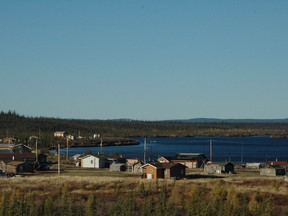'You can hear birds chirping': N.W.T. community's switch from diesel power to solar a success
A year after his tiny Arctic community became a test case for solar power in the North, it's the sounds that Alvin Orlias notices

Article content
By Bob Weber
COLVILLE LAKE, N.W.T. — A year after his tiny Arctic community became a test case for solar power in the North, it’s the sounds that Alvin Orlias notices.
“I’m standing outside right now and it’s quiet,” said the superintendent of Colville Lake’s unique solar-diesel power plant. “You can hear birds chirping in the background.”
The Dene hamlet of about 150 people north of Great Bear Lake made history last year by becoming the first in the North to replace its near-derelict diesel generator — a common problem in the region — with a combination of diesel, batteries and a solar array capable of generating 160 kilowatts.
The idea was to use diesel as a backup and during the winter, and turn to the sun for everything else.
Twelve months later, that’s about how it’s worked out, said Myra Berrube of Northwest Territories Power Corp.
“During periods when the batteries are loaded up or we’re getting good production out of the solar facility, we can in fact turn off the diesel. The community has made comment that it’s quiet.”
Berrube said about one-fifth of the town’s annual energy use now comes from the sun, even though the panels produce almost nothing between November and January. Just as important, the batteries allow more efficient operation of the diesel generator.
The corporation estimates that Colville Lake ran the generator at least 27 per cent less, saving it more than 37,000 litres of diesel fuel.
There have been bugs in adjusting and balancing the capacities of both systems. But the panels themselves are highly reliable and Orlias said he can resolve most problems on-site.
It’s a vast improvement over the old generator, which shut down an average of 31 times a year.
Colville Lake could be a glimpse of the future.
Outside Yukon’s abundant hydro power, almost all Canadian Arctic communities depend on giant diesel generators that get their expensive, high-carbon fuel delivered over ice roads and on barges.
A 2015 Senate committee concluded northern electricity systems are “aging, underperforming and at capacity.” Northern premiers regularly request federal funds to deal with the problem.
Some renewable energy already functions in the Arctic.
I come to work at 8:30 in the morning and it's quiet. The sun is out and generating power and powering the town
Biomass — also known as “wood stoves” — heats many homes. Wind turbines have been installed outside Whitehorse as well as in Rankin Inlet, Nunavut. Northwest Territories Power also operates solar arrays in Fort Simpson.
Interested observers from around the circumpolar North have already visited Colville Lake to take notes.
Berrube cautions that the community’s approach won’t simply be duplicated across the North.
“All our communities are different. There is no cookie-cutter approach on this.”
Wind may be more appropriate for some places. Others may not be as open to trying something new.
The Colville solution is also expensive.
The total cost was about $8 million and required $1.3 million in government funding. Calculations on how long it will take for the savings in diesel to pay for the solar panels haven’t been done yet.
But people like the new arrangement, said Orlias.
“I come to work at 8:30 in the morning and it’s quiet. The sun is out and generating power and powering the town.”
Our website is the place for the latest breaking news, exclusive scoops, longreads and provocative commentary. Please bookmark nationalpost.com and sign up for our daily newsletter, Posted, here.












